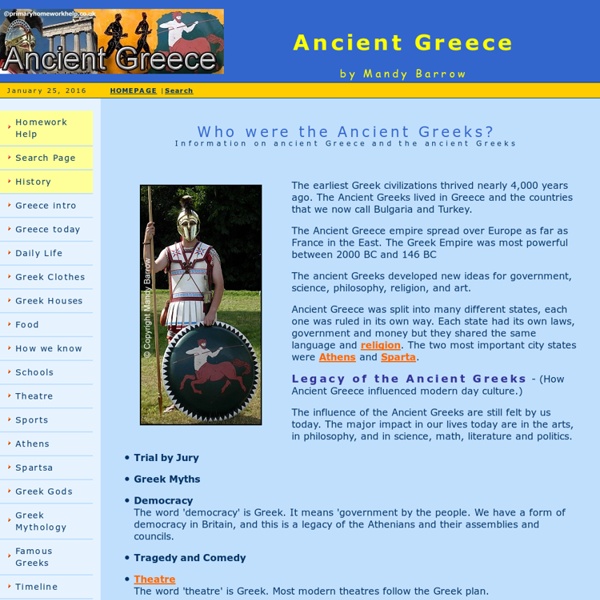Primary History - Ancient Greeks
Who were the ancient Greeks? Who were the ancient Greeks? Discover different ancient Greek cities and find out how they were ruled. How did the Olympic Games begin? Learn how the Olympic Games began over 2,700 years ago! What was it like to live in an ancient Greek family? What was everyday life like in ancient Greece? Who were the ancient Greek gods and heroes The Greeks believed in many gods and goddesses. The ancient Greeks at war Learn about ancient Greek soldiers, the Spartan soldier state and read about famous Greek battles. What do we know about ancient Greek culture? Find out what ancient Greek theatre was like and learn about different ancient Greek festivals and art How did the ancient Greeks change the world? What did the ancient Greeks do for us? 3 class clips We have a selection of great videos for use in the classroom Links BBC History for Kids
Ancient Greece
History: Ancient Greece for Kids
Ancient Greece was a civilization that dominated much of the Mediterranean thousands of years ago. At its peak under Alexander the Great, Ancient Greece ruled much of Europe and Western Asia. The Greeks came before the Romans and much of the Roman culture was influenced by the Greeks. Ancient Greece formed the foundation of much of Western culture today. Everything from government, philosophy, science, mathematics, art, literature, and even sports was impacted by the Ancient Greeks. The Acropolis of Athens by Salonica84 Periods Historians often divide up the history of Ancient Greece into three periods: Archaic Period - This period ran from the start of Greek civilization in 800 BC to the introduction of Democracy in 508 BC. Athens and Sparta were the two main city states that ruled much of ancient Greece. Fun Facts about Ancient Greece The Greeks often ate dinner while lying on their sides. Back to History for Kids
Ancient Greece - Q-files Encyclopedia
The Parthenon is a temple to the goddess Athena, completed in 432 BC. It was built in the Acropolis of Athens, the ancient citadel located on a rocky outcrop. The Parthenon (top) in Athens, built in 432 BC About 2500 years ago, Greece enjoyed a time of wealth, discovery and invention. A map of Greece in around 500 BC A map of Greece in about 500 BC Greek city-states Greece civilization grew up around the shores and islands of the Aegean Sea. This painting, called The School of Athens, by the Italian Renaissance artist Raphael, shows the Greek philosophers Plato (c.428–c.348 BC, left) and Aristotle (384–322 BC, right). The philosophers Plato (left) and Aristotle (right) Science and ideas The ancient Greeks had many ideas that have passed down to us today. Myths and drama Actors perform a play in an amphitheatre while the work of an ancient Greek town continues around them. Actors perform in an amphitheatre. The Greeks loved to listen to music, poetry and songs. Consultant: Philip Parker Timeline
Lectures by Sandra J. Shaw
ART HISTORY I LECTURE 18: The Parthenon and its Arts Free Sample Download of Lecture >> AH1L18sample.mp3 IMAGES: (for individual student reference viewing only) below: Artist's reconstruction of the sanctuary of Delphi, by Albert Tournaire, fellow of the French Academy in Rome, watercolor, 1894. below: Riace Warrior A, found near Riace, Italy, cast bronze, c. 6.5' h, c. 460-450 B.C. below: The Discus Thrower, by Myron, Roman copy in marble, c. 5' h, c. 450 B.C. below: West facade of the Parthenon, by Iktinos, Kallikrates, Karpion architects, Pentelic marble, c. 100'w x 228'd x 45'h, Acropolis, Athens, c. 447-432 B.C below: View from north-west of the Parthenon, by Iktinos, Kallikrates, Karpion architects, Pentelic marble, c. 100'w x 228'd x 45'h, Acropolis, Athens, c. 447-432 B.C below: Reconstructed model of the Acropolis, Athens. below: The Acropolis of Athens today: below: Reconstructed model of the west facade of the Parthenon. below: Reconstructed model of the Parthenon.
Ancient Greek Instruments
Kithara Lyra: originally called Chelys, because of the tortoise shell used as its sound box. According to Nicomachus of Gerasa (Ist cent. AD), the tortoise-shell Lyra was invented by god Hermes, who gave it to Orpheus. We don't know how many strings the original Lyras had. Cithara plucked instrument with 5 strings originally, but later with as many as 12 strings. Barbitos or Barbiton is an instrument of the Lyra family and resembles a Lyra, but it has longer arms and narrower sound box. Phorminx probably the oldest of the Cithara type instruments. Epigonion belongs to the psaltery family and it is the instrument with the largest number of strings, sometimes as many as forty (Polydeuces). Pandouris or pandourion, also called trichord because it had three strings, is the first fretted instrument known, forerunner of the various families of lutes worldwide.



